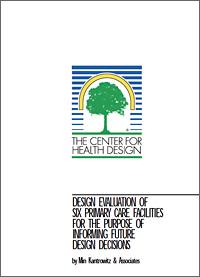Design Evaluation of 6 Primary Care Facilities for the Purpose of Informing Future Design Decisions

Primary care is a diverse, changing and critically important part of America's health care system today. This research project, sponsored by The Center for Health Design, is the first endeavor which begins to examine the implications that the changing primary care system has on the facility design.
The research project studied six primary care facilities -- one each located near Boston, Chicago, Detroit, Minneapolis, New Orleans, and Seattle. All were associated with a larger health care provider organization, and ranged in size from 10,000 square feet to 55,000 square feet. The definition of primary care varies among these six organizations. Each of these groups has taken the initiative to custom fit the mix of primary care services to meet the needs of the population and communities served. There is little recent published literature available to inform or guide designers, administrators, researchers or facility managers about successful primary care facility design. The designers of each facility carefully evaluated design issues -- such as flexibility, efficiency, and image -- and developed and implemented new and effective design solutions.
These designers reject the old sterile image of medical settings, instead providing comfortable, light, welcoming spaces which enhance patient, visitor and staff experiences. They pay careful attention to patient choice and privacy, staff interaction and abundant natural light. These facilities reflect their organizations' focus on health promotion and continuity of care, and a shift from large-scale to smaller scale facilities with a mix of centralized and decentralized functions which balance personal attention and efficiency. The facilities include patient education spaces and accessible community rooms. Most facilities have flexible, adaptable spaces and furnishings, appropriate to today's quickly changing health care scene.
These design concepts are consistent with trends in primary care, which include more emphasis on wellness in an efficiency-oriented, capitation-based health care environment; client and community orientation with an emphasis on convenient access; a shift from hospital care toward primary care and home care, with associated changes in training of a variety of health care providers; and the increasing importance of information and other technologies in health care.
This case study research was based on a very small sample of facilities, but it identifies a set of critical design issues faced by many involved with design, development, and operation of primary care facilities. As more primary care environments are designed, these issues deserve more rigorous examination, leading to research-based design guidance.


Add comment
Log in to post comments